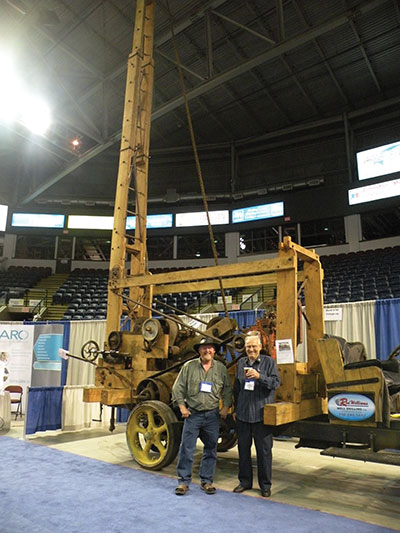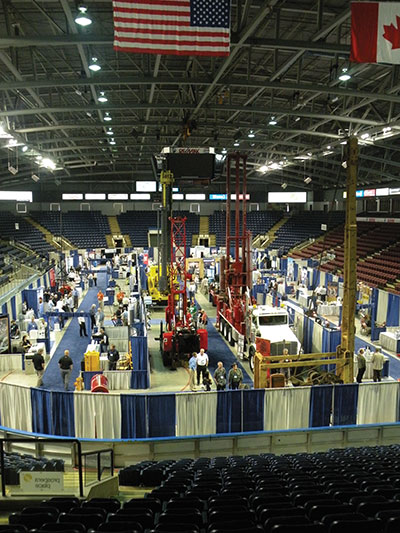
Features
Associations
Business
CanWell Recap
The thirst for knowledge was alive and well in B.C.
September 2, 2014 By Colleen Cross
Numbers may have been on the low side, but interest in education, networking and drilling equipment was high among CanWell attendees this year.
Numbers may have been on the low side, but interest in education, networking and drilling equipment was high among CanWell attendees this year.
 |
|
| Red Williams’ vintage rig, which he reconstructed over five years and features just one piece left of the original, weathered wood, got many appreciative looks. Advertisement
|
About 300 people in the water well drilling community attended the CanWell conference and trade show in beautiful Kelowna, B.C. The British Columbia Ground Water Association (BCGWA) hosted the conference, which took place at the Delta Okanagan Resort from June 10 to 14, and provided two streams of educational talks: trade and professional/technological. The variety seemed to satisfy association attendees, many of whom said the sessions were informative and thought-provoking.
Dr. Allan Chapman, a hydrologist with the B.C. Oil & Gas Commission, presented a talk on the professional side entitled “Enhancements in Groundwater Knowledge and Groundwater Management in Northeast British Columbia.” Chapman discussed how the commission’s recently launched Water Information Portal that pools data and displays it using flexible charts and analytical tools to help users understand and apply it.
On the trade side, Jim Bailey, well services director for U.S. consultants Shannon & Wilson, presented a lively description of impulse technology, which entails rehabilitating wells by destabilizing the surrounding fines. Bailey, who has worked with Pigati in Berlin on cutting-edge rehabilitation projects, demonstrated how alternating the method’s use with other techniques such as swabbing and surging often delivers more effective results than using the method exclusively.
Perhaps the most talked-about session, with about 50 in attendance, was Thursday’s open discussion about the possibility of forming a new national association. Bruce Ingimundson, president of the BCGWA, said organizers wanted to provide a setting for open discussion on the principle that “if you have seven drillers in the room, you’ll get eight opinions.”
Kevin Constable, former president of the former Canadian Ground Water Association (CGWA), summarized the events leading up to its demise and said he firmly believes there should be a central association and more involvement by members. Constable suggested a two-year rotation between an Ontario and a B.C. president as one way to save on costs and suggested that provinces shouldn’t have to belong to both a provincial and a national association.
Ingimundson asked if a regional association might work and Constable agreed that may be a good way to restart an association as long as it becomes national in scope.
Blaine Matuga, a BCGWA director, expressed concern about low numbers.
John Wilson, former member of the board for the CGWA, said that years ago they started with 30 board members and that was too many. The industry needs an organization that will serve as a lighthouse and revisited the idea of an association of associations, which had been voted down in the past.
“What’s good in B.C. is not necessarily going to fly in Atlantic Canada,” said Wilson. He disagreed with the notion of two-year executive rotation, suggesting two years is barely enough time to get to know the industry.
Rick Cronin, a former director of the CGWA, said there is no one national standard and some of the provinces may need help with certification. He noted that having an association would help prevent governments from taking control.
Colin Slade of Drillwell suggested that video conferencing could be a good option to lower communication costs.
In the end, an informal show of hands indicated those in the room were unanimously in favour of creating a new national body.
Ingimundson was encouraged by the healthy turnout.
“I got the sense that there is a real desire to rebuild an association and to have some kind of link between the provinces. It may take on a different structure and it will probably start on small scale, but the interest is there.”
Labour Shortage a Hot Topic
Another pressing industry issue was in the spotlight at a June 4 luncheon where Dan Kelly, vice-president of the Canadian Federation of Independent Business, drew on compelling statistics to explore the challenge of a widespread labour shortage.
Everyone is in hiring mode, said Kelly. Seventy-one per cent of business owners are working longer hours. Sixty-eight per cent of members are drawing poor-quality applicants, in some cases snapping up those who simply show up on time. Two-thirds said they hired someone based on such criteria even when not qualified. Many are just getting by, let alone expanding their businesses.
Strategies for overcoming the shortage include emphasizing soft skills such as communications, creating tax incentives, bolstering apprenticeships (for example, looking to apprenticeship success stories, such as those in Germany), freezing employment insurance premiums and taking advantage of the new Canada Job Grant.
Vintage and New Drill Rigs
On the trade show floor at nearby Prospera Place, cool drills and rigs turned heads. A rig built by Henry Peters and Frank Adams in 1971 featured a Wisconsin engine and main mechanical drive unit that came from an early 1950s New Holland hay baler.
Rob Caho, director of sales for Diedrich Drill, drove a shiny red D-50 track drill all the way from Indiana. With a rated depth of 125 to 250 feet, the drill is geared to the environmental geotechnical industries, explained sales associate George Long.
But most will agree Red Williams’ mystery rig stole the show. Williams, who owns Red Williams Drilling, came looking for answers about the vintage rig he bought from a Mr. Hanson in Bracken, Sask., and reconstructed using mostly wood. He suspects the machine, which drilled its last well in Climax, Sask., was built between 1890 and 1910, but would like to know its make, its year and whether or not it is assembled correctly. Readers can contact him with information at red_drilling@shaw.ca.
The Buzz
Attendees seemed pleased with the variety of products on display and the breadth of education offered.
 |
|
| Rigs, vintage and new, caught the eye of CanWell-goers in Kelowna. About 300 industry people took in research talks and walked the colourful trade show in early June.
|
Peter Wells and Nathan Maljaars said they enjoyed their first CanWell experience, singling out Craig Nichol’s talk on the hydrogeology of the Okanagan Basin and ongoing UBCO research, and Jim Bailey’s talk on impulse technologies. “It really made me think about the pros and cons of adopting the technology,” said Wells.
David Pye of Red Deer College’s Water Well Driller program said there was a lot of interest in the college’s new Earth Loop Technician program. While second-period dates for the program for 2015-16 have not been finalized, the first term, which begins Nov. 10, is open for registration.
Michael and Heather Friesen of Friesen Drillers in Steinbach, Man., also said they got a lot out of the show, but echoed Dan Kelly’s labour concerns. Michael said their biggest challenge these days is finding workers and they have had to pay more to keep good people once they find them.
With a raft of products and technologies, impressive rigs on display, and opportunities for learning and catching up with friends, CanWell had something for everyone.
Long time driller Ken Slade’s rhetorical comment may have summed it up best: “What don’t I like?”
Print this page